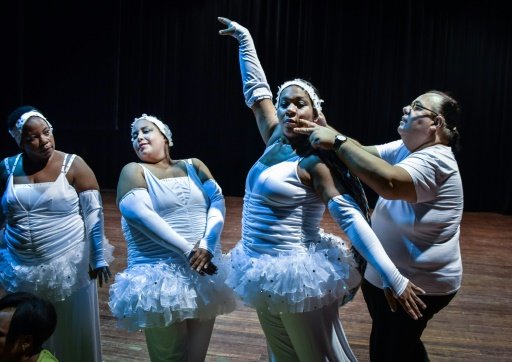
With wide waists in white tutus, their figures are far from those of typical ballerinas — but these plus-size Cuban dancers are determined to defy stereotypes.
In a land with a fiercely demanding dance tradition, the women have turned their large physique into an artistic virtue, proudly taking to the stage to perform “Swan Lake.”
“You don’t come here to lose weight. You come here to feel like a ballerina,” says Juan Miguel Mas, founder of the Danza Voluminosa troupe.
“You are fat and you have the desire and the need to express yourself through movement.”
– Fighting fat –
Cuba is world renowned for its slim, rigorously trained dancers.
But 44 percent of its population is overweight, according to 2012 figures from state nutrition body SISVAN.
Members of Danza Voluminosa typically weigh between 100 and 120 kilos (220 to 265 pounds), but there is no limit.
Mas, 50, a trained dancer with a rotund figure himself, founded the group in 1996.
It once had 20 members, but only seven remain. Some left and two have died from obesity-related illnesses.
“It has not been easy,” says one of the members of the troupe, Maylin Daza, a 36-year-old housewife.
“We have lost companions to obesity. And here we are, still fighting.”
– ‘Soft, wide bodies’ –
Mas set out to use his own professional dance experience to train people “with bodies like mine, softer and wider.”
“I had the idea of creating a space where those people could train and develop, and of creating dances using these bodies,” he said.
“It helps obese people to develop not only artistically, but also socially.”
The ballerinas, all women, practice twice a week in Mas’s small apartment in Havana’s working class Marianao neighborhood.
Mas has spent 20 years exploring ways of making an overweight body move “aesthetically better” — developing elegant moves adapted to bigger figures.
“Our dances will not be the same as thin people’s dances,” he says.
– Winning over the audience –
The group recently put on a series of shows for the public.
“The first few times we performed, there was this deathly silence. Some people got up and left. Some laughed,” Mas recalls.
“But when people saw how developed our work was and how impressive, with so much work behind it and such aesthetic meaning, in the end they applauded. We won over the audience.”
Then one night in early January, three dancers from the troupe found themselves stepping out in front of an audience at the elite National Theater in Havana.
In white tutus, leggings and headdresses, they stepped along in tight formation to Tchaikovsky’s score.
– ‘Fat women don’t dance ballet’ –
There are no jumps and few bends. In rehearsal, the ballerinas groan when made to hold a move for several seconds.
But in the dressing room, excitement reigns.
“I’ve always liked classical dance,” said Daza. “But everyone knows fat women don’t dance ballet. And in my family no one helped me to lose weight.”
The National Theater show was part of a cultural exchange between the University of Massachusetts and the Cuban writers’ and artists’ union UNEAC.
For the dancers, it is a measure of how far they have come.
Pulling on her long white gloves, Rubi Amaro recalls her first performances with the group.
“It wasn’t easy at first,” the 34-year-old said. “At the start people laughed. They didn’t like it. But others did.”
“Now they pay more attention to the choreography. No one laughs at us now,” she added.
